How To Plant And Grow Hydrangeas – A Sheltered Spot And Regular Watering Is A Must

SHRUBS > HYDRANGEA
Reviewed By ROY NICOL

Roy is a Professional Gardener and Horticultural Consultant, specialising in large garden year-round maintenance and garden development. He is an RHS Master of Horticulture and uses his research in the application of no-dig methods in ornamental garden settings. Roy has been a Professional Gardener for more than six years and is a member of the Chartered Institute of Horticulture, Professional Gardener's Guild and Association of Professional Landscapers (Professional Gardener).
Contributions From JUDITH BLACKLOCK

Judith is the author of eighteen best-selling books on flower designs, arrangements and recipes - and is known for teaching at events including the RHS Chelsea Flower Show. She opened Judith Blacklock Flower School in Knightsbridge in 2001, which is accredited by both the British Accreditation Council (BAC) and the American Institute of Floral Designers (AIFD). Judith is a Fellow of the Institute of Horticulture.
IN THIS GUIDE
Hydrangeas are those pretty chameleons of the plant kingdom that red-shift or blue-shift their flowers’ hues depending on the soil pH.
These long-lived perennials are mostly deciduous and bear richly-coloured flower-heads over long blooming seasons.
They occur in sedate as well as arresting tones of colours ranging from reddish pink to blue, often with rather differently coloured flowers on the same branch.
“I love Hydrangeas because they are so useful in floral design work, particularly in big installations,” shares Floral Designer Judith Blacklock.
Overview
| Botanical Name | Hydrangea |
| Common Name(s) | Hydrangea |
| Plant Type | Shrub |
| Native Area | Asia and Central / South America |
| Hardiness Rating | H5 (evergreen species H4) |
| Foliage | Deciduous or evergreen |
| Flowers | Corymb clusters of flowers with 4-5 petals |
| When To Plant | October, November |
| When To Prune | March, April, November |
Sunlight
Preferred
Full Sun, Partial Sun or Full Shade
Exposure
Sheltered or Exposed
Size
Height
0.5 – 2.5M
Spread
1 – 2M
Bloom Time
Summer / Autumn
Soil
Preferred
Most fertile soils
Moisture
Moist but well drained
pH
Acidic – Neutral
Hydrangea is a flowering plant that is represented by an immense number of varieties that reliably produce lush corymbs of dainty flowers in many gorgeous shades, from soft cream to vivid purple.
They bloom during summer and autumn.
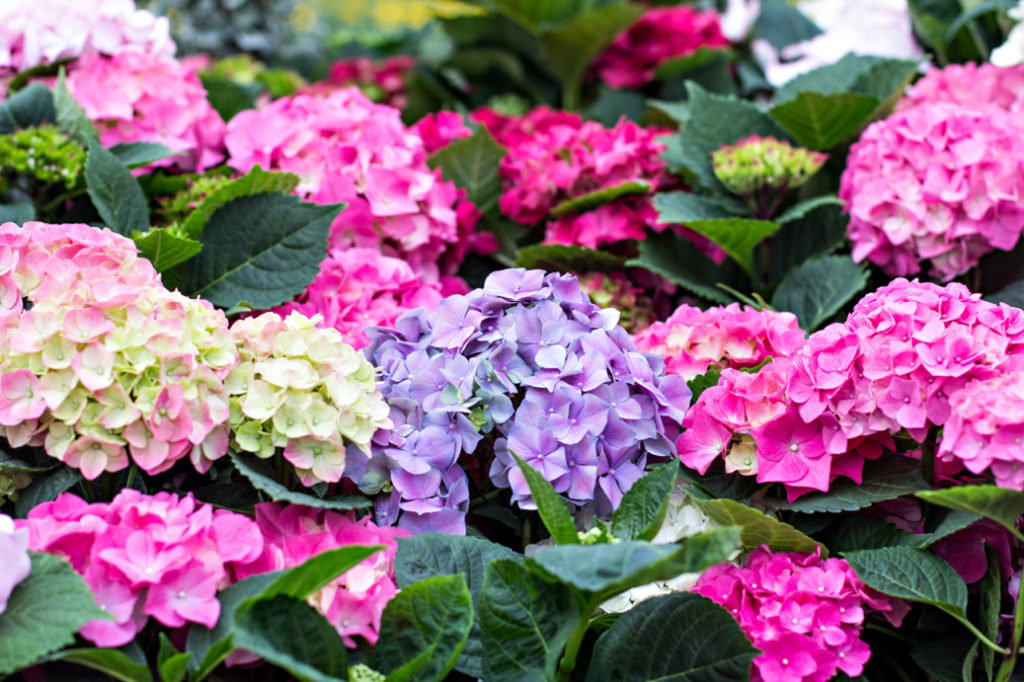
The hydrangea genus numbers roughly 80 species plus several hundred cultivars.1The BRAHMS Project, University of Oxford, Department of Plant Sciences. (n.d.-f). Hydrangea species. Oxford University Plants. Retrieved March 20, 2023, from https://herbaria.plants.ox.ac.uk/bol/plants400/Profiles/GH/Hydrangea
A majority of the flowering garden plants commonly referred to as ‘Hydrangeas’ descend from H. macrophylla, while H. paniculata, H. aborescens and H. serrata are three other species that are parents to popular garden plants.
Garden hydrangeas should not be confused with climbing hydrangeas which are, you guessed it, climbers.
Several varieties derived from H. paniculata grow to be small trees, while a few others stemming from species like H. quercifolia make great bushes and hedges.

In this article we focus on hydrangea, the deciduous bushy shrub that typically attains heights of 50-150cm.
“A key point to bear in mind with Hydrangeas is they require plenty of moisture to grow well, as stated by the plant’s name, which comes from the Greek word Hydra, meaning water,” explains Gardener and Master Horticulturist Roy Nicol.
“Therefore, in warm weather, regular watering is a must or you can install an irrigation system.”
Garden Hydrangeas
What one might call ‘Garden Hydrangeas’ are classified into several groups.
The popular and most commonly-grown ones in the United Kingdom are Hortensia Hydrangeas.
They derive from H. macrophylla and are further sub-divided into mophead and lacecap types.
In the United States, Oakleaf Hydrangeas, which derive from H. quercifolia are among the most popular.
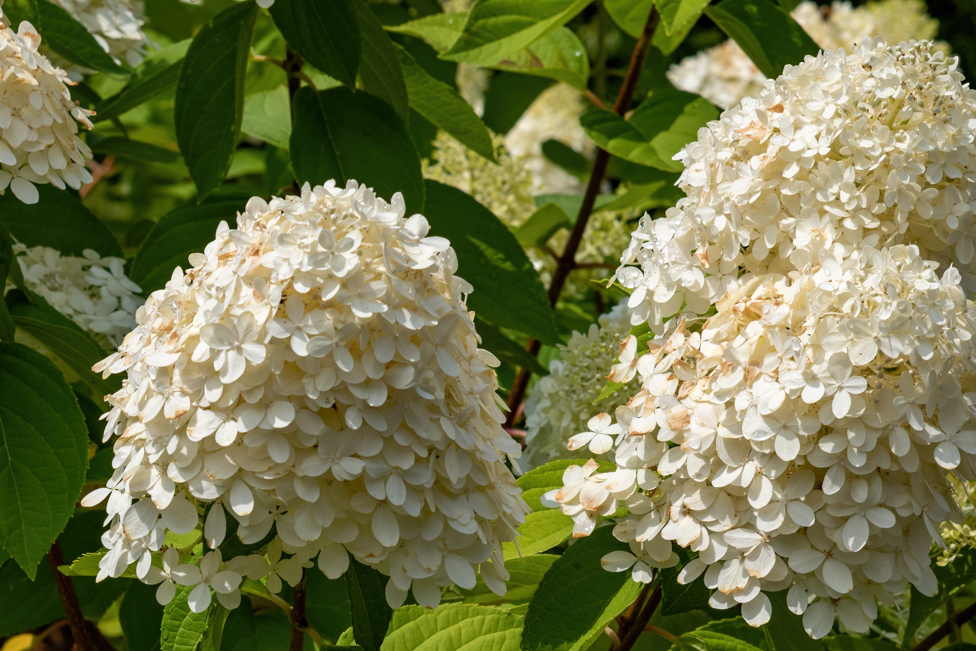
Panicle Hydrangeas, which descend from H. paniculata, are also grown on both sides of the pond.
Hydrangeas enjoy a well-deserved reputation as the chameleons of the plant kingdom.
The chameleonic ones descend from H. macrophylla and the colours of their flowers shift between red-pink for soils with alkaline pH to blue for soils with acidic pH.
They go purple for pH levels in between, with the bloom colour able to be influenced by you, the gardener.
In nature, the parent species’ flowers occur in colours within this same range.
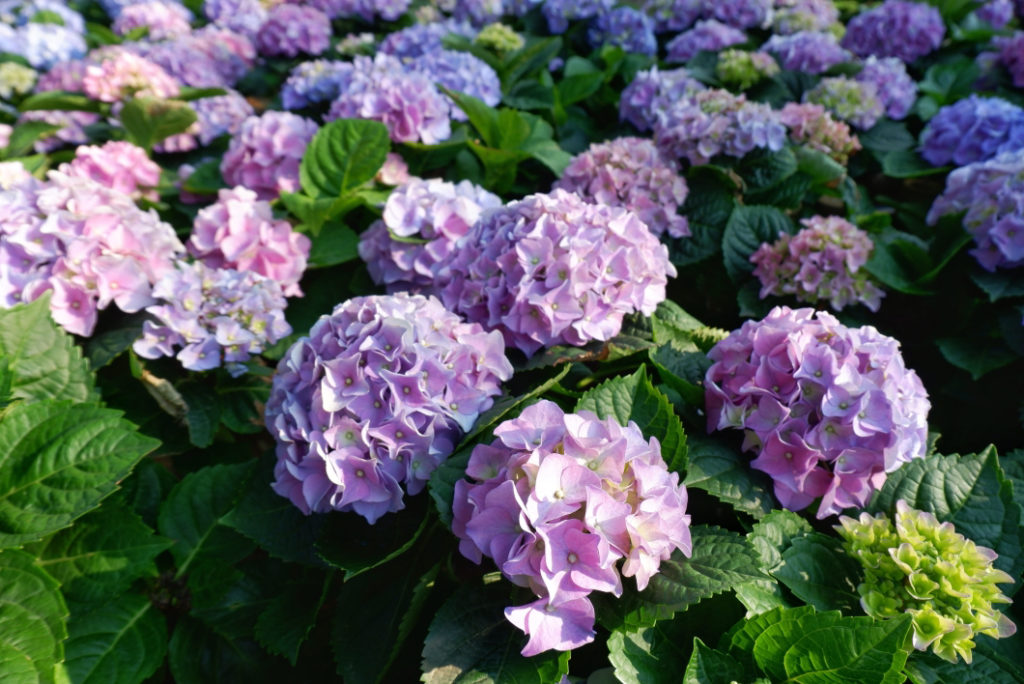
The flowers occur in dense, usually rounded, corymbs or flower-heads.
The ‘flowers’ are composed of four sepals in the softest lilacs through to the most vibrant reds, and they include bicoloured blooms as well.
H. macrophylla varieties, or Hortensia Hydrangeas, have especially attractive foliage.
The leaves are of brilliant, rich green shades and are beautifully ‘cut’ as they display quite a decorative serrated margin and a fine oval to elliptical shape.
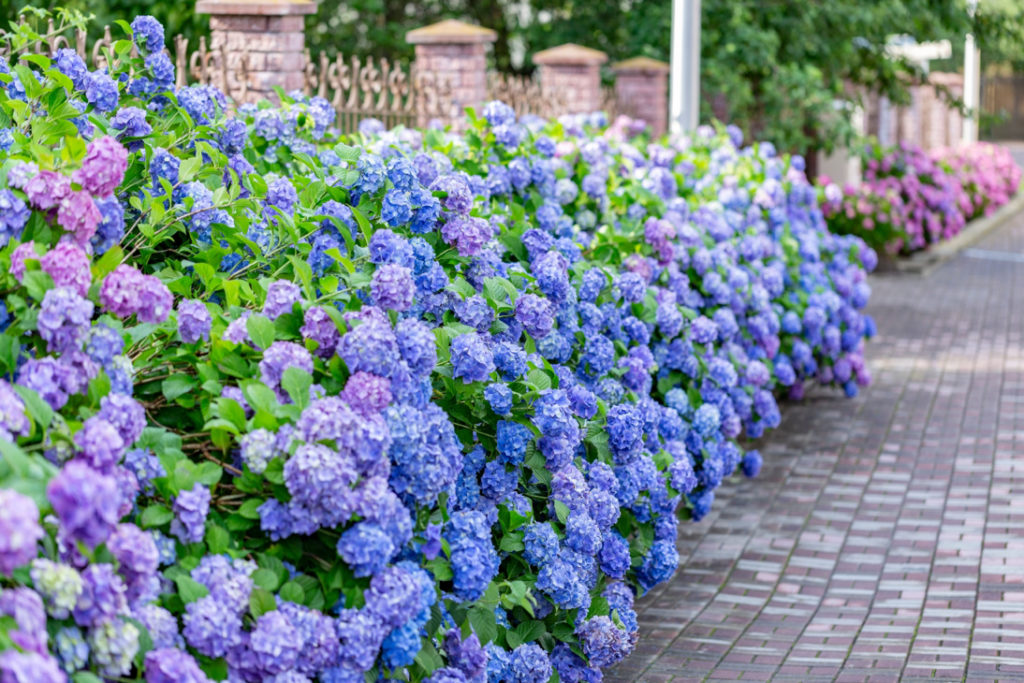
Add to all these attributes hydrangeas’ low maintenance needs, their floriferousness, and their long flowering season, and it is easy to see why these plants have never experienced a dip in popularity.
Planting Guidelines
Hydrangeas are commonly bought in the form of potted plants.
You can leave them in the container they came in, transplant them, or re-pot them.
Where To Plant
The ideal location for these plants will bring them sun in the morning and shade or filtered sunlight in the afternoon.
Hydrangeas are generally best sited in a sheltered spot; specifically, they should be sheltered from the North wind.
A layer of mulch will keep the soil temperature stable and thereby protect the roots from the ill effects of both high and low temperatures to which Hydrangeas are quite sensitive.
Repotting / Transplanting
The best season to transplant or re-pot is a month or two after the flowering season is over, which would be sometime in autumn.
The best time to do it is in the morning.

Potted plants should be potted on about every three years as a general rule, or when the roots become visible through or in the drainage hole at the bottom.
The plant should be re-potted to the next-bigger size pot.
To transplant, prepare a hole in the soil about as deep as the container that the plant is in and nearly twice as wide.
After removing the plant with the soil from the pot, ensure that the roots are not root-bound.
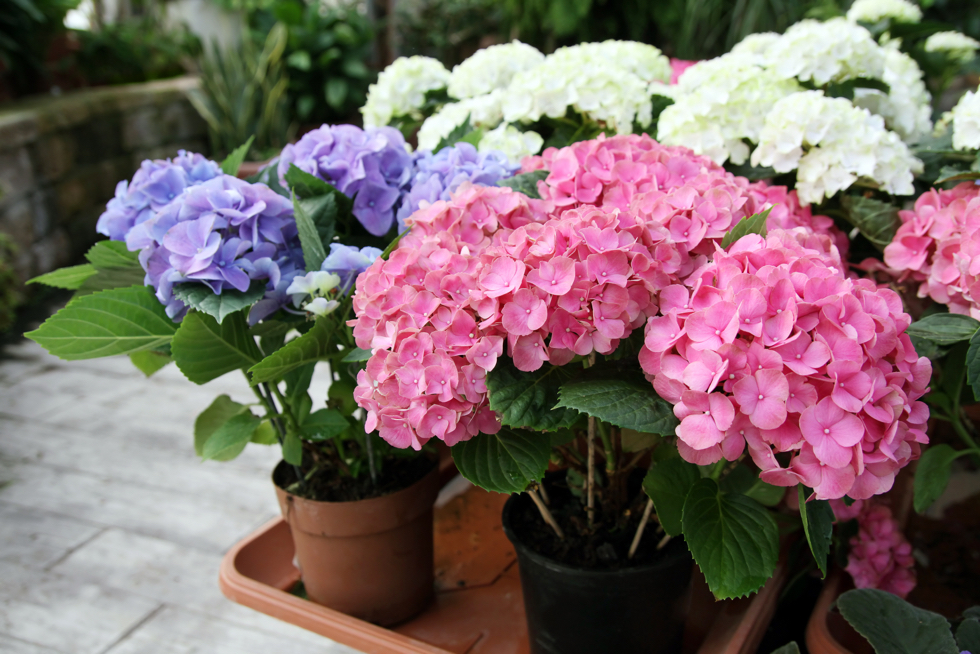
If they are, gently spread them out but this should be done quickly as hydrangeas should be re-potted or transplanted quickly and efficiently.
Spread the roots and backfill the hole, taking care that the soil line is the same as it was in the container and not lower.
Give the transplanted (or re-potted) plant a deep watering.
Plant Care & Growing Tips
Soil Requirements
The best soil for Hydrangeas is a rich loam composed of sand, chalk and clay amended with organic compost.
The soil should drain well but retain moisture, which may be accomplished by adding vermiculite to the soil.
Hydrangeas will do well in widely varying soil pH; however, a slightly acidic to neutral soil pH is considered ideal.2Williams, T. (2012, September 20). Hydrangea blooms turn colors based on soil pH levels. CAES Newswire. Retrieved March 20, 2023, from https://newswire.caes.uga.edu/story/4542/blue-pink-or-lavender.html
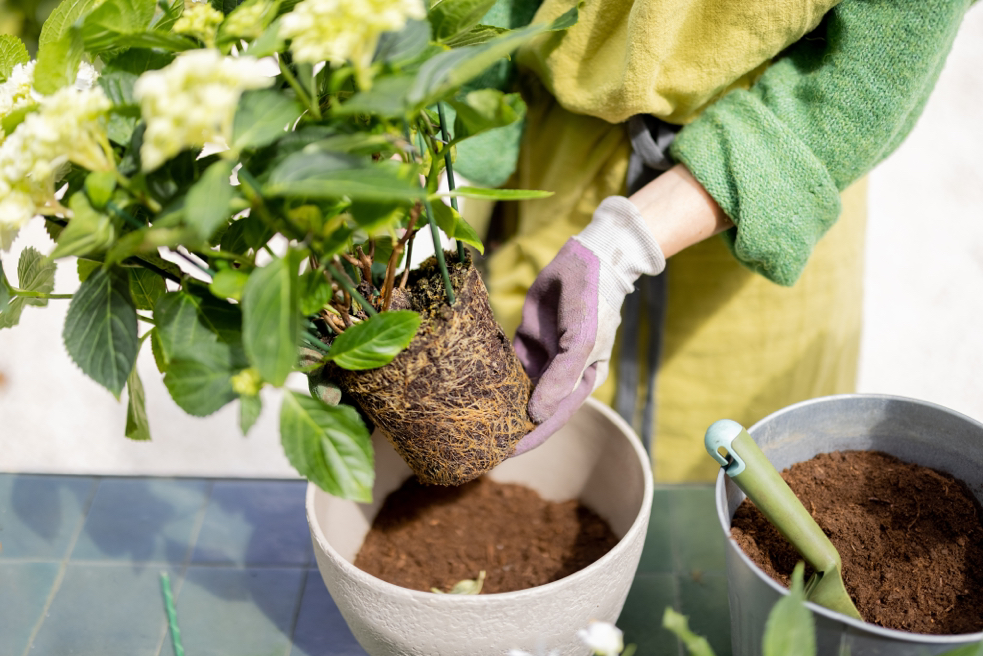
In this range a given variety’s flowers’ hues will stay true to type and not veer toward either red-pink or blue.
Varieties that bear purplish flowers and multi-hued flowers will also perform very well.
Watering
These plants need deep and thorough waterings during the growing season.
About twice a week is sufficient.
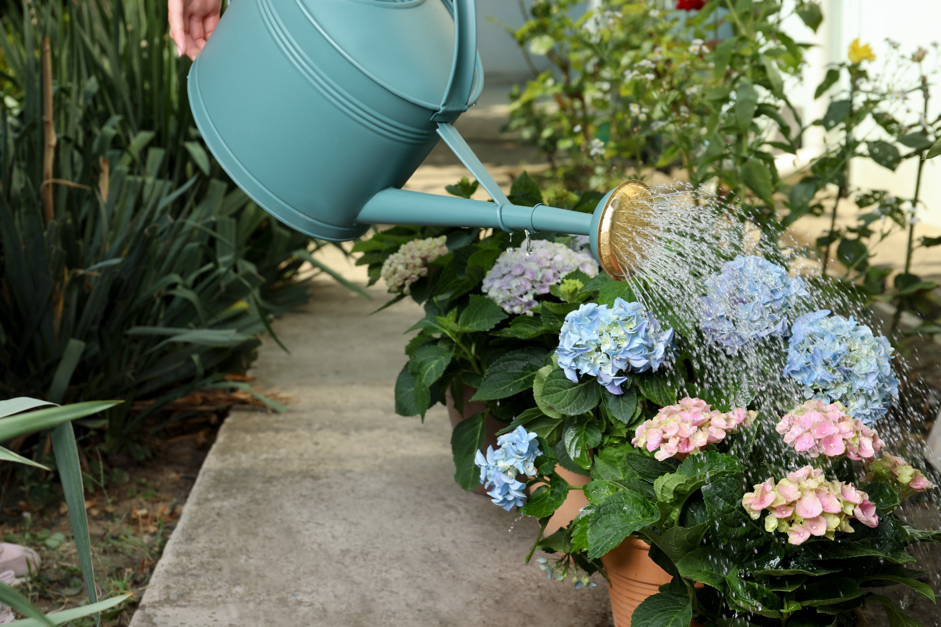
The soil should stay just moist, especially in summer.
When the top centimetre of soil feels dry, it is time to water again.
Feeding
Hydrangeas may be fertilised once a year.
Do so in spring just when the plant has started to put out leaves.
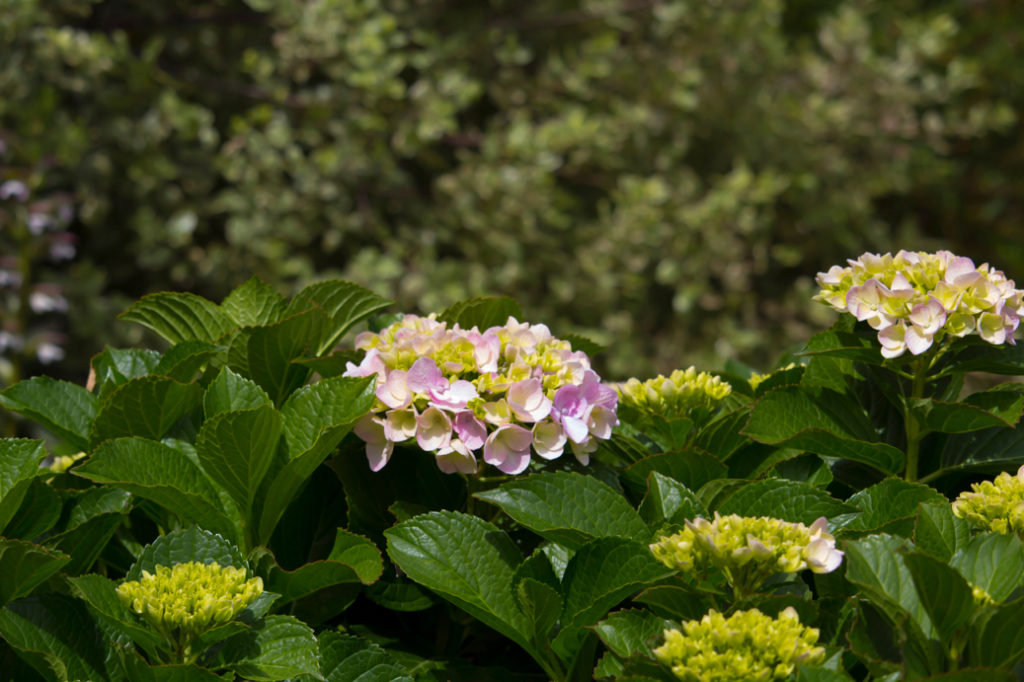
Use a conventional balanced fertiliser or alternatively, simply apply organic compost or (a lighter application of) organic manure.
Where feeding Hydrangeas is concerned, the saying ‘less is more’ ought to be kept in mind.
References
- 1The BRAHMS Project, University of Oxford, Department of Plant Sciences. (n.d.-f). Hydrangea species. Oxford University Plants. Retrieved March 20, 2023, from https://herbaria.plants.ox.ac.uk/bol/plants400/Profiles/GH/Hydrangea
- 2Williams, T. (2012, September 20). Hydrangea blooms turn colors based on soil pH levels. CAES Newswire. Retrieved March 20, 2023, from https://newswire.caes.uga.edu/story/4542/blue-pink-or-lavender.html

